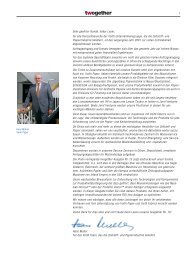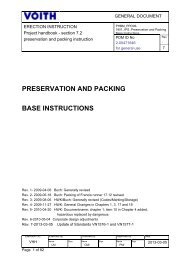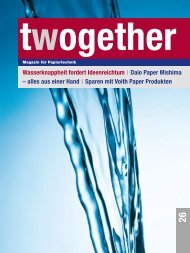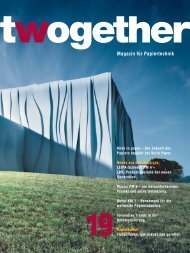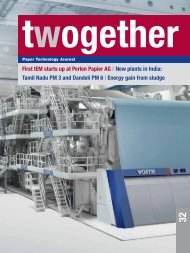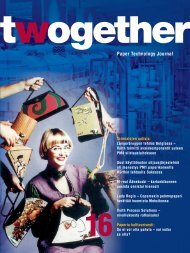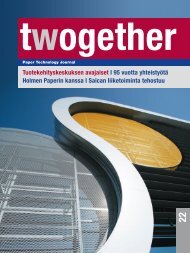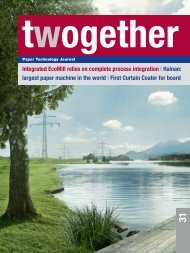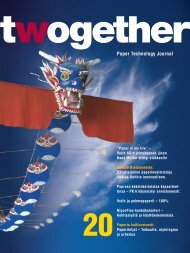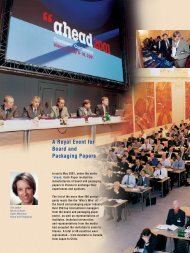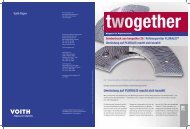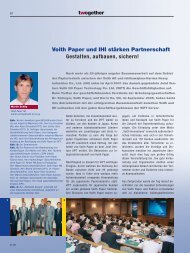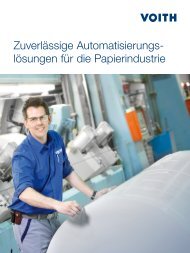Paper Technology Journal - Voith
Paper Technology Journal - Voith
Paper Technology Journal - Voith
Create successful ePaper yourself
Turn your PDF publications into a flip-book with our unique Google optimized e-Paper software.
Fig. 1: View of the RCF plant buildings<br />
in Kemsley.<br />
The recovered paper warehouse can<br />
store up to 15,000 tonnes. All main stock<br />
preparation machines as well as the<br />
water treatment equipment are located<br />
in the machine building, with a floor<br />
area of 7600 m2 . Fig. 1 shows the machine<br />
building with the adjacent warehouse<br />
for recovered paper.<br />
In the surrounding industrial zone, two<br />
large paper mills are located quite nearby.<br />
This enabled us to enter into an appropriate<br />
service contract with the service<br />
organization already supplying the<br />
two paper mills with power and steam<br />
and also taking care of effluent and<br />
waste material disposal. Total investment<br />
for the deinking plant was 43 million<br />
pounds Sterling. Plant capacity is<br />
110,000 tonnes per year finished stock.<br />
This requires processing approx.<br />
180,000 tonnes of recovered paper per<br />
year. The recovered paper consists of<br />
unsorted, mixed office papers. To<br />
achieve the necessary tonnage, the plant<br />
must operate 363 days per year.<br />
Chronology of the plant construction<br />
Construction work started in September<br />
1994 with the demolition of unused<br />
buildings, and the foundations were laid<br />
in October 1994. The first machines were<br />
installed in March 1995 and installation<br />
of the plant was completed by September<br />
1995. The first phases in commissioning<br />
the plant then began, and production<br />
of deinked pulp started on the 11th of<br />
Stock Preparation<br />
Table 1: Process data<br />
Pulping consistency 18 - 22%<br />
Specific pulping energy 28 - 30 kWh/t<br />
Reductive bleaching 0.65% stabilized dithionite (Hy-Brite)<br />
Oxidative bleaching 1.3% peroxide (H2O2, 100%)<br />
Flotation additives 1% soap + 0.01% synthetic foaming agent<br />
Overall specific dispersion energy 160 - 180 kWh/t<br />
Table 2: Quality comparison<br />
Parameters Unit UKP 100% SF 50% SF chem.pulp 100% LF 100% SF/CTMP<br />
DIP chem. pulp 50% LF chem. pulp chem. pulp (bleached)<br />
Brightness % ISO with UV 100 91 90 90 85<br />
% ISO w/out UV 86.5 91 90 90 85<br />
Dirt speck mm2 /m2 4-6 1-5 1-5 1-4 1-6<br />
area (ppm)<br />
Stickies mm2 /kg < 80 < 20 < 20 < 20 < 40<br />
Freeness<br />
Tensile<br />
CSF 400 460 420 500 470<br />
index<br />
Tear<br />
N · m/g 50 49 66 81 41<br />
index mN · m2 Burst<br />
/g 10.8 7.1 10.9 11.1 9.3<br />
index kPa · m2 /g 3.3 3.8 5.8 7.8 2.9<br />
(SF = short fibre, LF = long fibre)<br />
November 1995. At the end of January<br />
1996 optimization work commenced. The<br />
amount of sludge “produced” annually<br />
in the RCF plant is 70,000 tonnes. It<br />
comes out of the system with a dry content<br />
of 60% and is used to improve<br />
neighbouring agricultural land. This form<br />
of sludge utilization is carried out under<br />
the supervision of the government<br />
authority ADAS (Agricultural Develop-<br />
11<br />
ment and Advisory Service). The average<br />
content of inorganic components (ash) in<br />
the sludge is around 70%. Apart from<br />
sludge, some 3% of plastic and metal<br />
waste is removed and then disposed of<br />
on the communal rubbish dump.<br />
Finished stock production was 73,000<br />
tonnes in 1996, the first year of operation,<br />
and production for 1997 was set at



